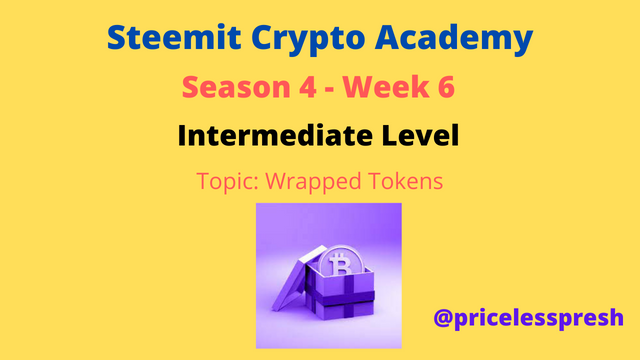 Cover Image Created on Canva
Cover Image Created on Canva

1.- Name at least 2 Blockchains that use Wrapped BTC, excluding Ethereum, and show screenshots. Explain.
All blockchain networks have a unique characteristic, that is their native token can't be accessed by other blockchain networks. As beautiful as it seems it also became a problem. Two of the core problems are interoperability and liquidity. This issue was resolved through what is known as Wrapped Tokens.
One of the most popular blockchain tokens to be converted to a wrapped token is Bitcoin. Bitcoin is by far the largest cryptocurrency in the world in terms of market capitalization and the price of the token. However, users of Bitcoin had an issue, they couldn't use their tokens on another platform to enable them to partake in the financial activities of these platforms.
A solution was therefore necessary and when provided brought about Wrapped Bitcoins WBTC. Wrapped Bitcoin is a new type of Bitcoin that can be used on another blockchain network. Even though it is wrapped it still has the same properties as the original Bitcoin.
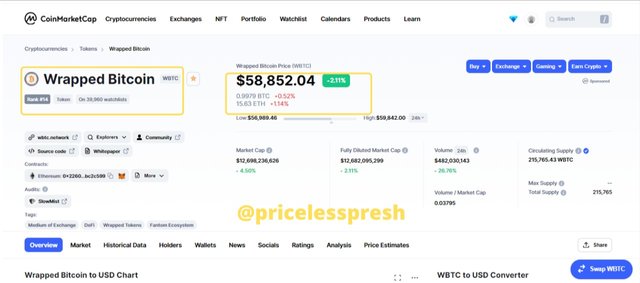
We can see that a wrapped version of Bitcoin has been created and it has the same price as the original Bitcoin. The purpose of this wrapping is to enable investors in Bitcoin to use their tokens in another platform without friction and with the speed of transactions. This then means that Bitcoin is now interoperable with other blockchains through its wrapped form and also these other blockchains experience high liquidity on their platform.
I shall be discussing two other blockchains that use wrapped Bitcoins.
Polygon Blockchain
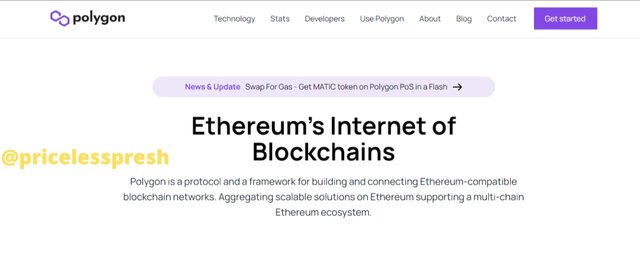
Polygon is a network that provides services to other blockchain networks. They help these blockchains to be able to operate on Ethereum's network and also to make their network scalable. That is, they aim to make transactions between different cryptocurrencies seamless and at the same time eliminate slower transactions. They use a Proof-of-Stake (PoS) consensus mechanism to help scale Ethereum's network.
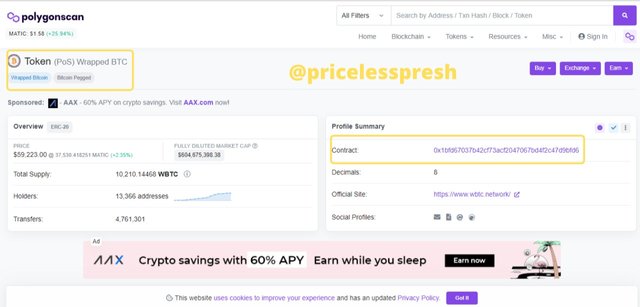
Polygon is one of the blockchain networks that provides wrapped Bitcoins. This is achieved through BadgerDAO service BadgerBridge. Users who have Bitcoins can connect to Polygon using BadgerBridge and convert their Bitcoins to wrapped Bitcoins.
Polygon has its explorer (Polygonscan) where a view of wrapped Bitcoin is shown. The contract address is given and some other pieces of information are given.
Solana Blockchain
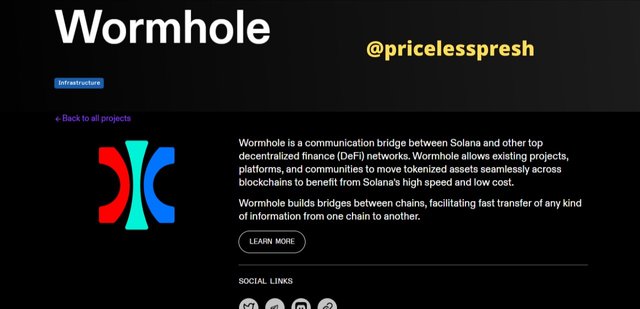
Solana is another blockchain network that makes use of wrapped Bitcoins. Solana is a blockchain that is regarded as "the blockchain platform for decentralized apps". This means that their blockchain allows developers to build on their blockchain because it is highly scalable. It makes use of Proof-of-Stake (PoS) and Proof-of-History (PoH) which is a novelty consensus mechanism that deals with the time of transactions. These two combined make Solana's blockchain to be the fastest in the world with respect to transaction time.
It provides wrapped Bitcoins services through Warmhole. Wormhole is a decentralized application (dapps) that lets other blockchain networks especially those in the decentralized finance (defi) category, to be able to access Solana's blockchain network.
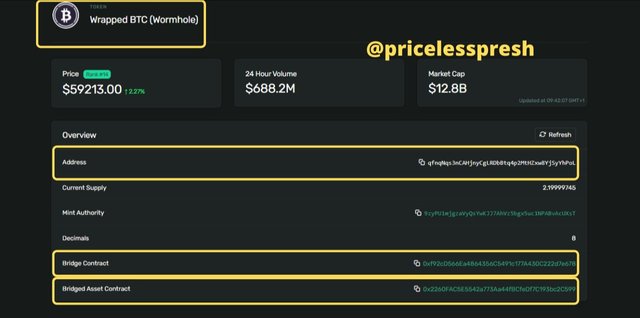
On Solana's explorer, when you type WBTC on the search icon, you would get a result showing WBTC. When you click on it you would get into the information box regarding WBTC on Solana's network. On it, you can see the contract address, the bridge contract, and the bridge asset contract.

2.- What is the difference between the wETH of the Ethereum platform and the wETH of the TRON platform? Explain.
WETH on Ethereum's blockchain and WETH on Tron's blockchain are the same because they perform the same function of allowing owners of the Ethereum coin ETH to be used on different platforms and easily.
However, there is are some marked differences between WETH on Ethereum's blockchain and WETH on Tron's blockchain. I shall be going through them critically.
WETH on Ethereum's Blockchain
First of all, WETH is a token and not a coin because it is created as an ERC-20 token, which means that it has been tokenized and can be used for smart contracts. Ethereum is a network that allows different blockchain networks to operate on it. Because of this, it created a token standard where projects operating on the network can create their tokens from. Some of these crypto projects provide decentralized services and some other services that are needed by investors.
This makes it that its native coin ETH cannot operate on some of these projects. Because the standard use to create the original coin ETH is different. Also, investors on the network had a difficult time trying to access these crypto projects using ETH. It is because of this that a new token WETH was created. Mind you it still has the same attributes as ETH, but it can be used on Ethereum's blockchain as an ERC-20 token which allows it to be used on different blockchains that run on Ethereum's platform. In addition, WETH is created by developers on the Ethereum network and is managed on the network, it is not created by an external entity.
WETH on Tron's Blockchain
WETH on Tron's blockchain is not an ERC-20 standard token, but a TRC-20 standard token. Simply because it is being used on Tron's network. Tron network has an ecosystem of crypto projects that offer decentralized services too and at a lower cost. This means that the standard used to create their tokens is TRC-20. So investors who want to use ETH on Tron's network can do so and it would be a TRC-20 standard.
Another thing to point out is that since Tron is not the creator of ETH, they can't produce a tokenized version of it. A company is in charge of managing WETH for holders on Tron's network. They do this by minting new wrapped Ethereum tokens and burning them after use. The company is BitGo.
We can see a summary of the differences between WETH on Ethereum's blockchain and WETH on Tron's blockchain.
| SN | WETH on Ethereum Blockchain | WETH on Tron Blockchain |
|---|---|---|
| 1. | The tokens can only operate on Ethereum's network | The tokens can operate on both networks |
| 2. | Used to trade with ERC-20 tokens | Trades with TRC-20 tokens |
| 3. | The token is decentralized in nature | Token not decentralized in nature (centralized) |
| 4. | Developed by developers in Ethereum | Created by BitGo |
| 5. | It is an ERC-20 standard token | It is a TRC-20 standard token |
| 6. | It runs on the Ethereum network | It runs on the Tron network |
| 7. | It does not undergo a burning process | It undergoes a burning process |

3.- Make an investment of at least $ 5 of a Wrapped token. Explain the process with screenshots. You can use the JustSwap platform.
In this exercise, I would be doing an investment of $5 worth of TRX on a wrapped token. For this illustration, I would be using JustSwap and making an investment in WETH. These are the processes involved in doing the investment.
- Go to the site JustSwap and click on connect wallet on the left of the screen. Then click on Tronlink Wallet. You must have signed in to your Tronlink wallet before connecting to it.
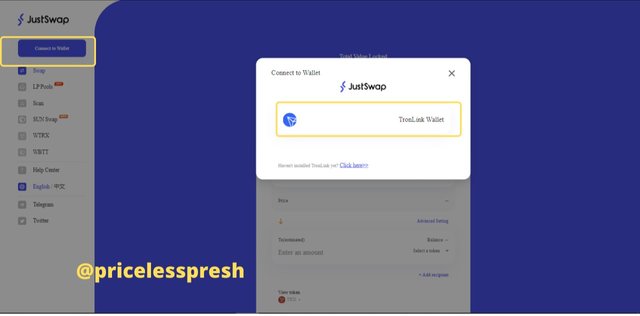
- On the platform, there are two sections where you can Swap or Pool tokens. I would make a swap of tokens. Then you go ahead to choose the tokens you want to swap and the amount to be swapped. For this exercise, I would swap TRX to WETH.
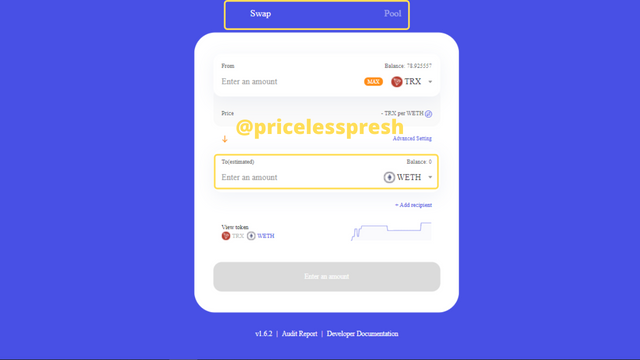
- To perform the swap, you must first input the amount of TRX to swap. So I put 70 TRX which is equivalent to 0.001478 WETH. When converted it gives $5.595. After that click on Swap.
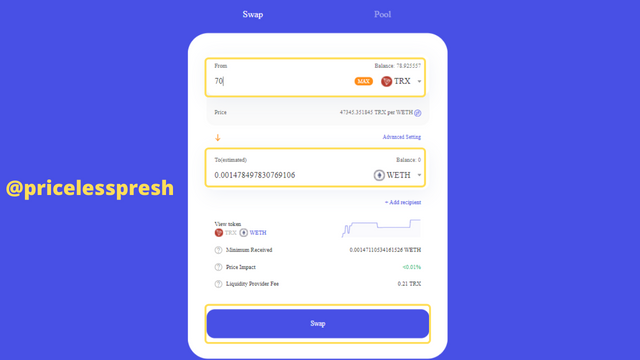
- A window would now show indicating the amount of TRX to swap and the amount of WETH you would receive in return would display. It also shows the fee that the liquidity provider would take. Then click on Confirm Swap.
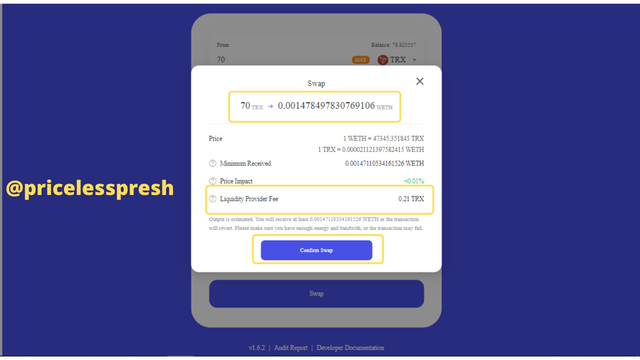
- A pop-up requesting our signature would display. Click on Sign.
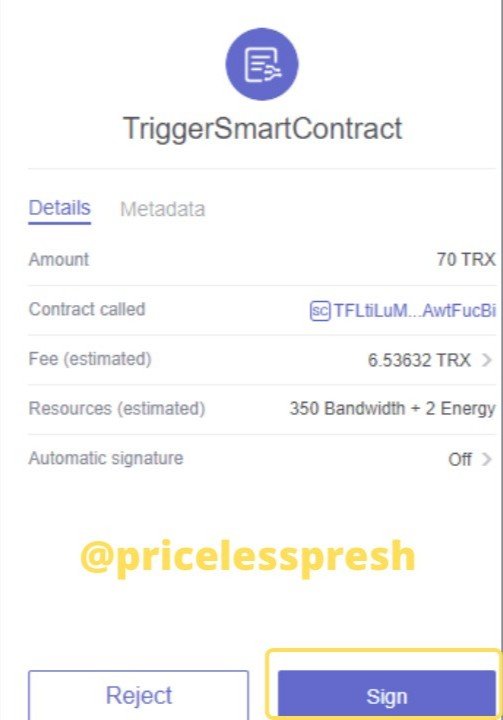
- A display to show the status of the transaction would display. In this case, it is Confirmed.
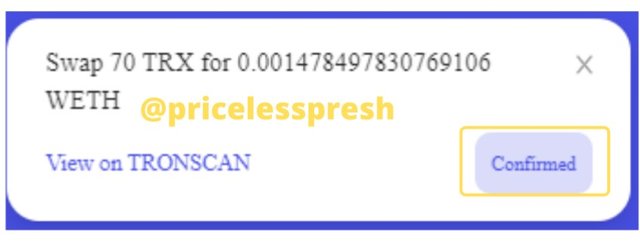
- To have a second confirmation of the transaction I checked my Tronlink wallet. You can see that I have acquired WETH.
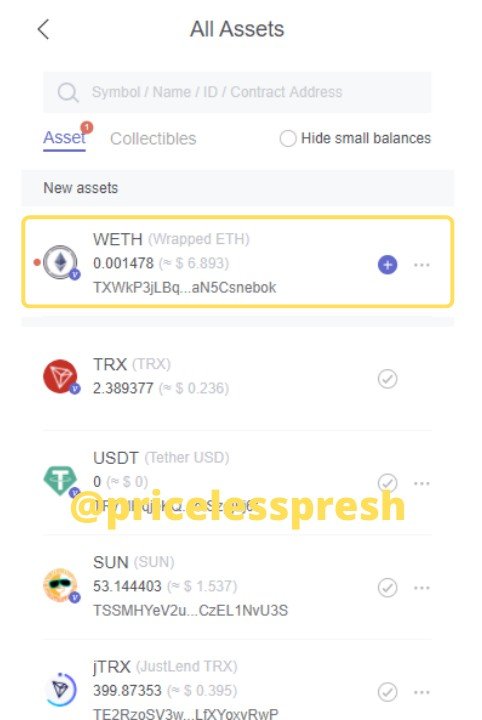

4.- Explain in detail the Wrapped token of the TRON Blockchain. Show screenshot.
Tron's blockchain network has experienced some upgrades which have boosted the credibility of the network. One of such upgrades is the inclusion of other cryptocurrencies into their platform. These currencies come in their converted (wrapped) form and can be used as a TRC-20 token on Tron's blockchain.

To get a good view of the wrapped tokens, I visited tronscan.org. I was able to get a view of some of the wrapped tokens that can be found on Tron's network. On the home page I clicked on tokens, from there I was able to get a list of all the types of token that is used on Tron's network.
In addition, I noticed that the wrapped tokens can be grouped into different categories. I shall be discussing the wrapped tokens based on their categories.
The first category involves wrapped tokens of the native blockchain. That is, wrapped tokens of coins used on the Tron network. They are:
WTRX
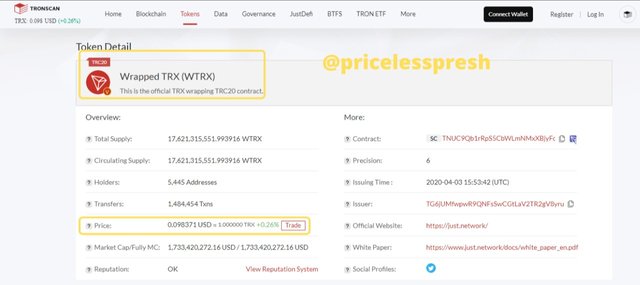
TRX is the native token of Tron's blockchain. But it was the first token to be created using the TRC-10 standard. At that time smart contract operations were non-existent. In today's world of blockchain technology, you can't talk about cryptocurrency without mentioning smart contracts. That said, Tron created a wrapped version of TRX so that it can be operated on different smart contract projects in its ecosystem. You can see the price, the contract address, and the official website of the token. The provider of the token is the Tron network. It has a trade that indicates that the token can be traded with other tokens on the network.
WBTT
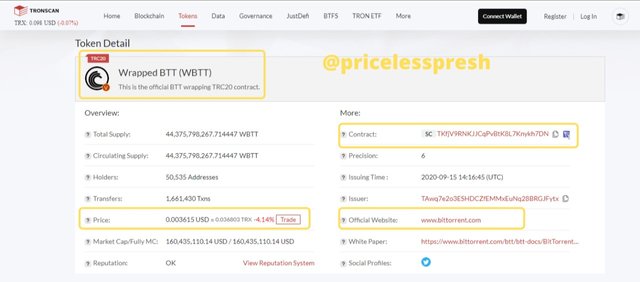
BTT is a native token of Tron's blockchain. It was created as part of the TRC-10 tokens on the network, this makes it that it cannot be used to operate on the smart contract projects that are operating on the Tron network. Due to this, it was part of the native token to be created to work with smart contracts. The wrapped version is a TRC-20 token and can operate on any project producing smart contracts on Tron's blockchain. You can see the price, the contract address, and the official website of the token. It has a trade that indicates that the token can be traded with other tokens on the network. The provider of the token is the Tron network.
Next is the category of wrapped tokens that are from a foreign blockchain network. They are:
WBTC
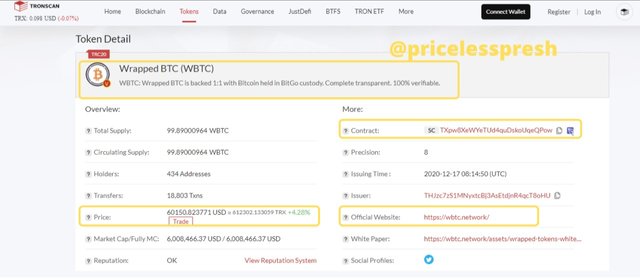
Wrapped Bitcoin was included in Tron's network to enable interoperability. That is, owners of Bitcoins can operate on Tron's network by making use of the wrapped Bitcoin. You can see the price, the contract address, and the official website of the token. The provider of this token is BitGo which is a centralized entity that is in a partnership with the Tron network. It has a trade that indicates that the token can be traded with other tokens on the network.
WETH
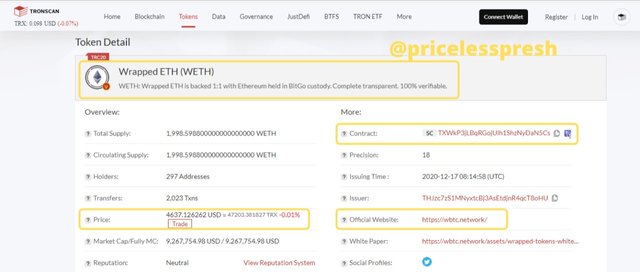
This is the wrapped version of ETH on Tron's network, it has the same characteristics as the original Ethereum. Owners of ETH can operate on Tron's blockchain using WETH. You can see the price, the contract address, and the official website of the token. It has a trade that indicates that the token can be traded with other tokens on the network. The provider of this token is BitGo which is a centralized entity that is in a partnership with the Tron network.
Yet another category is a list of wrapped tokens that have been listed on Tron's blockchain but are in the developmental stages. They are:
WDOGE
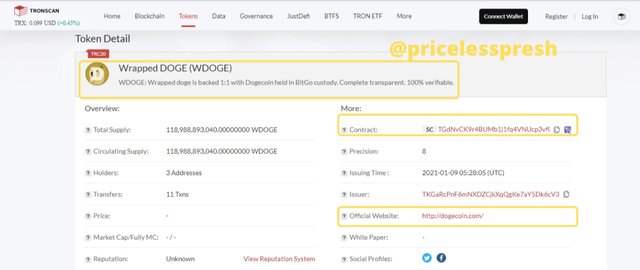
Wrapped DOGE is another token that is set to operate on Tron's blockchain. It is still in the developmental phase which the network developers are hard at work on it. Once fully launched it can be exchanged for other tokens on Tron's blockchain and can be used to operate smart contracts. There is no price listing at the moment, but it has a contract address, and the official website is shown. It is provided by BitGo which is a centralized entity that is in a partnership with the Tron network.
WUNI
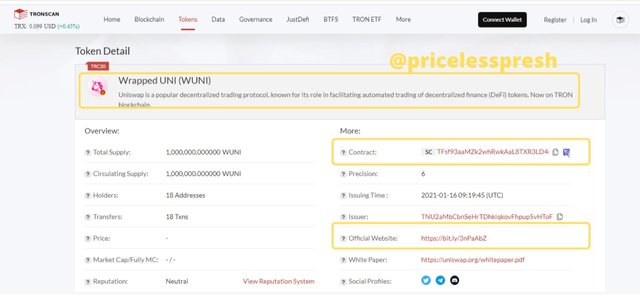
Wrapped UNI is another token that is set to operate on Tron's blockchain. It is still in the developmental phase which the network developers are hard at work on it. Once fully launched it can be exchanged for other tokens on Tron's blockchain and can be used to operate smart contracts. There is no price listing at the moment, but it has a contract address, and the official website is shown. It is provided by BitGo which is a centralized entity that is in a partnership with the Tron network.
WDOT
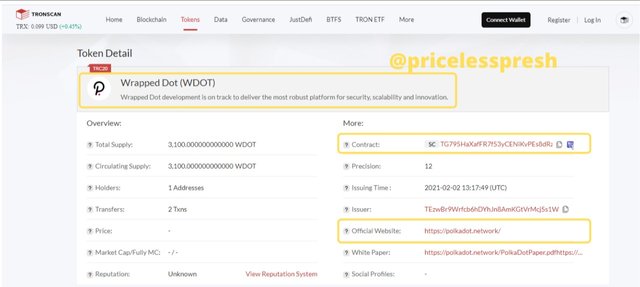
Wrapped DOT is another token that is set to operate on Tron's blockchain. It is still in the developmental phase which the network developers are hard at work on it. Once fully launched it can be exchanged for other tokens on Tron's blockchain and can be used to operate smart contracts. There is no price listing at the moment, but it has a contract address, and the official website is shown. It is provided by BitGo which is a centralized entity that is in a partnership with the Tron network.
Finally, there is a wrapped token that is found of tronscan. I'm not sure if the token is verified or not. They are:
WLTC

At first, when I saw this token, my initial thought is that is a wrapped token that Tron's blockchain intends to add to their network. But looking at the details on the block, made me think otherwise.
There we have it these are all the wrapped tokens I could find on Tron's network.

5.- What is to mint a Wrapped token? What is burning a Wrapped token? What is your function? Create an example explaining the process.
What is to mint a Wrapped token?
Minting is the creation of a new wrapped token. It is a process that is carried out by the entity in charge of creating the tokens. Along with the entity in charge of providing the wrapped tokens, it also consists of the exchange that issues the wrapped token, and the final user that is in need of the wrapped token. For instance, if an individual who owns Bitcoins BTC wants to operate on Tron's network, he can't do that because BTC cannot be used in Tron's network, so he has to request a wrapped Bitcoin WBTC. When he does so, the exchange would then send a request to the entity providing the wrapped BTC for an exact amount of the BTC requested, because the wrapped token and the original token have the same value.
When the entity receives the request, they must wait for 6 confirmations of the BTC transactions orders before the minting process is started. When the WBTC is formed it is then sent to the exchange who then sends it to the user who requested it.
What is burning a Wrapped token?
Burning is simply a process of destroying a wrapped token that was once created. It is equally a process that is solely carried out by the entity in charge of managing the tokens. For instance, the individual who had previously requested for wrapped Bitcoin WBTC has traded on the Tron network and made some profits, and now wants to convert the surplus realized back to the original coin BTC. He then makes a request to the exchange for the original coin BTC, the exchange then makes a request to the entity in charge of managing the wrapped token while transferring the wrapped token to the entity. This process is the reverse process of the minting process.
When the entity receives the request, it waits for 25 confirmation orders to be complete before the original BTC of the same value with the WBTC is sent to the exchange, who then sends it to the individual.
It is important to carry out this burning process because it makes the transaction irreversible which prevents having two of the same type of coin, at the same time prevent double-spending, and also making sure there is a balance of accounts, where wrapped tokens created is equal to the original token submitted.
Create an example explaining the process.
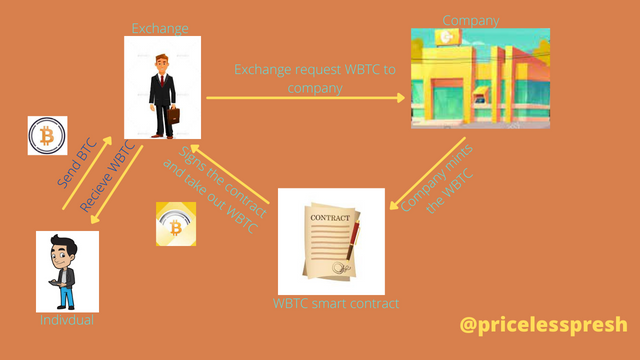
Just as I have explained in the Minting and Burning processes involved previously. An individual decides to do a swap on a decentralized exchange on Tron's blockchain but has only BTC. Obviously, he cannot use the BTC because it is not operational on Tron's network.
So the individual get new knowledge about wrapped tokens and is directed to a trusted exchange to make a request of WBTC. Then the individual is made to deposit the amount of BTC he wishes to convert to WBTC. The exchange after confirming the deposited BTC requests for WBTC from the company in charge of providing WBTC by sending the BTC of the individual to the company.
The company now mints a new WBTC in the same amount of BTC received and blocks the BTC. The exchange signs the contract to receive the newly minted WBTC after which it is sent to the individual.
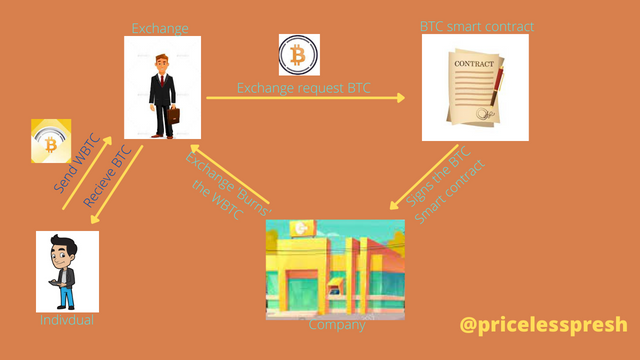
After doing some operations on Tron's blockchain, the individual now decides that it wants to take its BTC and invest back in the Bitcoin network. The individual then requests BTC from the exchange and then deposits WBTC.
The exchange then requests the BTC from the company, the company signs the smart contract associated with the request. The company unlocks the BTC and sends it to the exchange. The exchange then Burns the WBTC and transfer the BTC to the individual.

Conclusion
The concept of wrapped tokens is a welcome development to the blockchain industry. This is because it allows interoperability between different blockchains. This is of great importance because anyone can now operate on any blockchain of his choice with his coins. This also has a positive effect on the market as the difficulty that was one experienced in trying to do transactions across different blockchains is no more.
It also allows investors to save costs in transaction fees. Due to the mechanisms behind these blockchains, some costs more to run transactions than the others. This may not be favorable for the investors. Now an investor can decide to invest in a different blockchain using the coin of his native blockchain. Also, in the new era of decentralized finance, wrapped tokens have the potential to unlock the much-needed liquidity that defi projects badly need.
All these said there is one drawback to wrapped tokens. It is created by a centralized entity. This is contrary to the principles being taught and followed in the decentralized community because it is the top authorities that control the operations and not the network. However, I feel since the centralized entity is working with the decentralized entities, it doesn't have that much control.
CC:
@pelon53
Gracias por participar en Steemit Crypto Academy Season 4, Semana 6:
Tu trabajo estuvo muy bien realizado y con mucho orden. Veo que te esforzaste por hacer un buen trabajo.
Me hubiera gustado ver en el wLTC que aparece como una estafa, ya que lo nombras.
Muy bien explicado el acuñado y quema de los Wrapped tokens.
Buen trabajo, felicitaciones.
Recomendaciones:
Calificación: 9.5
Downvoting a post can decrease pending rewards and make it less visible. Common reasons:
Submit
Downvoting a post can decrease pending rewards and make it less visible. Common reasons:
Submit